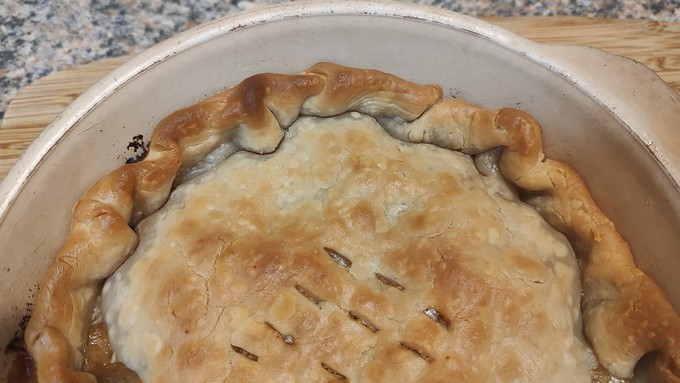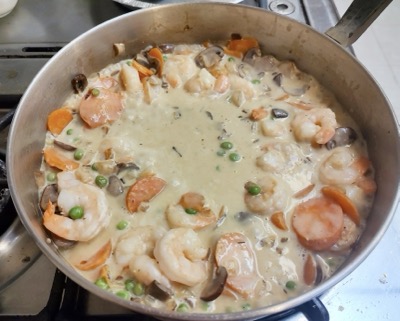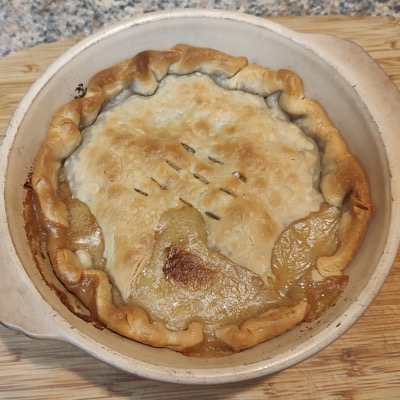
Recipe: Shrimp pot pie with fresh peas, carrots and spring onions

What's below the crust? Shrimp and a delicious collection of fresh vegetables. Debbie Arrington
The first time I had shrimp pie was at an antebellum plantation mansion-turned-B&B on Louisiana’s River Road. The place also served dinner because it was too far away from any restaurants in the middle of nowhere next to the mighty Mississippi. (It was possibly haunted, too.)
There were no menu choices; just a Creole-inspired prix fixe dinner. Before that meal, I had never considered the possibility of a shrimp pie. I couldn’t wait until I got home to California to make one myself.

That was almost 40 years ago, and I have been “playing” with the recipe ever since.
Pot pie is best with spring vegetables such as fresh peas and carrots and mild spring onions. Try not to overcook the shrimp; they can turn tough.
The rich sauce is just enough to keep everything moist underneath that single crust. Use a prepared crust or, if you prefer, one from scratch.
Shrimp pot pie
Makes 4 servings
Ingredients:
Butter or cooking spray for baking dish
¾ pound large shrimp, cleaned and tails removed
1 teaspoon Old Bay seasoning
Juice of ½ lemon
2 tablespoons butter or more as needed
1 spring onion, chopped
6 button or cremini mushrooms, sliced
1 carrot, sliced into thin coins
1 cup fresh peas, shelled
½ teaspoon dried thyme
½ cup dry white wine
¼ cup heavy cream
¼ cup milk
1 prepared 9-inch pie crust
Flour
Instructions:
Butter or spray a deep 8-inch casserole dish. Set aside.
In a bowl, sprinkle shrimp with seasoning and lemon juice; stir.

In a large heavy pan over medium heat, melt butter. Add shrimp and sauté briefly on both sides until the shrimp just turns pink, about 2 minutes a side. With a slotted spoon, remove the shrimp from the pan and set aside.
Add more butter to the pan if needed. Add onion and sauté until soft. Add mushrooms and sauté to soften, about 2 to 3 minutes. Add carrots to the mix and sauté another 2 minutes. Add peas and sauté until bright green, about 2 minutes more.
Add thyme and white wine to the pan and simmer until the wine is reduced by half, about 5 minutes (or less). Stir in the heavy cream and milk. Cook until sauce thickens slightly. Stir in shrimp and let cook 1 minute more. Remove from heat.
Preheat oven to 400 degrees F.
Transfer the shrimp filling into the prepared casserole dish. (Use a deep dish; the filling will bubble.) With floured hands, top the filling with the pie crust. The crust can sit on top of the filling or stretch across the top of the dish. Make several slits in the crust.
Bake in a 400-degree oven until the crust is golden and the filling bubbles around the edges, 30 to 40 minutes. Bake the pie on top of a baking sheet to catch any overflow.
Remove from oven. Let cool 10 to 15 minutes, then serve.
Comments
0 comments have been posted.Sacramento Digs Gardening to your inbox.
Sites We Like
Garden Checklist for week of July 21
Your garden needs you!
* Keep your vegetable garden watered, mulched and weeded. Water before 8 a.m. to reduce the chance of fungal infection and to conserve moisture.
* Feed vegetable plants bone meal, rock phosphate or other fertilizers high in phosphate to stimulate more blooms and fruiting. (But wait until daily high temperatures drop out of the 100s.)
* Don’t let tomatoes wilt or dry out completely. Give tomatoes a deep watering two to three times a week.
* Harvest vegetables promptly to encourage plants to produce more. Squash especially tends to grow rapidly in hot weather. Keep an eye on zucchini.
* Pinch back chrysanthemums for bushy plants and more flowers in September.
* Remove spent flowers from roses, daylilies and other bloomers as they finish flowering.
* Pinch off blooms from basil so the plant will grow more leaves.
* Cut back lavender after flowering to promote a second bloom.
* It's not too late to add a splash of color. Plant petunias, snapdragons, zinnias and marigolds.
* From seed, plant corn, pumpkins, radishes, winter squash and sunflowers.